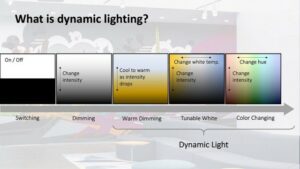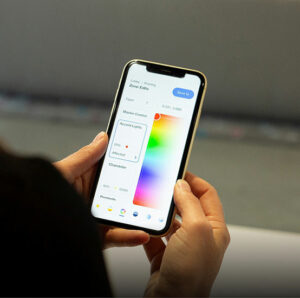Coloring Outside the Lines
‘Inside-the-box’ applications such as warm dimming and eye-catching façades are well established, but the true power of dynamic lighting lies in more unconventional uses. Here are five examples

IES Published 15 April, 2021
By Craig Casey
We celebrate electric light as a differentiator in the built environment. In A Social History of the Very Tall Building in America, George Douglas wrote, “Without the elevator and the electric light, the skyscraper could have been nothing but a dark and unpleasant cave rising out of the ground.” Electric light, widely distributed, was a revelation.
In the 1960s, the dimmer made lighting even more personal. We could now shape light to suit our moods, save energy, and go beyond function to fashion and aesthetics. Now, new light sources and control technologies have ushered in the era of light that is digitally controlled, flexible and responsive, and able to reflect the natural progression of daylight with changes in both color temperature and intensity.


This is dynamic light—a new tool that unlocks tremendous possibilities in design; that goes beyond basic dimming with advanced capabilities including warm dimming, tunable white and full spectrum control, inviting an even more symbiotic relationship between light and the people in a space.
Today, we continue to incorporate dynamic light into our designs: using warm dimming where we want the feeling of incandescent light; incorporating tunable white to help future-proof our designs, allow for changes over time and mimic daylight; embracing full-spectrum lighting for novel effects, memorable façades and eye-catching displays.
As exciting as these applications are, they represent “inside-the-box” design. The true power of dynamic light lies in “outside-the-box” ideas that can change the way we interact with a space, redefine the way we experience the built environment and re-engage our most creative ideas about what lighting brings to architecture and design.
We’ll look at five areas of opportunity: visual indicators; enhancing merchandise; enhancing food and art; changing self perception; and facilitating research, all with a goal of pushing the limits of the imagination. Because lighting is practical, essential and ubiquitous, but it can also be unconventional, magical and groundbreaking.
- Visual Indicators and Wayfinding
Lighting can be creatively used to provide visual cues that help eliminate confusion, minimize awkward interactions and smooth the flow of traffic. In the current environment, while we are all navigating COVID-19 protocols, visual indicators may facilitate more comfortable social distancing and identify areas in a workplace or public area that are in use and unavailable.
Think about conference rooms or meeting areas convenient for impromptu meetings, video calls and confidential phone calls. Incorporate full-spectrum lighting outside the room that is programmed to respond to room status. A quick glance at the light outside the space can minimize embarrassing interruptions, or a loud knock at the door during an important presentation. Integration between lighting and room-booking apps makes it even easier to ensure the visual indicator reflects the actual status of the room.
Corporate office design is trending toward space that is more flexible, resilient and accommodating of increasingly fluid work patterns. One of those design trends is “hot desking” in which employees are not assigned to a permanent office space or desk, but rather can select any available space in the open-office layout.
Even with desk-booking apps, it can be difficult to locate the exact space you just reserved. With integrated dynamic lighting, the employee can touch a button on their app and the light over their workstation can change color, guiding them quickly to their workstation without having to rely on a tell-tale coffee cup to indicate a coworker has already claimed that desk.
Beyond the workplace, these same principles can be applied to retail stores looking to maintain a safe space between shoppers, identify available dressing rooms, or even indicate that an area needs maintenance or cleaning. Visual cues are an immediate, familiar reference that don’t depend on the tech-savvy nature of the customer and don’t rely on finding a busy salesperson to help you navigate the shopping experience.
Visual Indicators: Design Considerations
- Source gamut – choose a light source with at least three saturated LEDs (e.g., RGB).
- Include sensors – occupancy detection is required to accomplish many of these goals.
- Plan for integration – ensure the features you need are available through the control system provider’s API (intensity, chromaticity, occupancy status, etc.).
- Think through the Sequence of Operations – the details matter. For example, how does the lighting respond once the employee arrives at the selected workstation? Does the employee have to access a keypad to regain control? Is there a wireless keypad at each desk? Is the lighting controlled via an app?
2. Enhancing Merchandising to Facilitate more Confident Purchases
In the retail space, customers must feel confident in their purchasing decisions. The unfortunate reality of static white lighting is the customer who gets home and notices the product looks different in their living room light than it did in the store. The customer may feel frustrated, potentially returning the item or rethinking the shopping experience in that store. With today’s dynamic lighting capabilities, the space can be designed with lighting that more accurately reflects the color appearance of that piece of clothing in a variety of lighting conditions.
Work with retail managers and buyers to understand where this merchandise is most frequently worn. Design simple, engaging lighting with intuitive controls in fitting rooms, for example, that can help a customer see how that item will look in a variety of lighting scenarios. Clearly labeled buttons can allow a customer to recall preset scenes and make it easier to evaluate the way the customer will look once they leave the store.
Enhancing Merchandising: Design Considerations
- Control button labels – fitting room keypad buttons can be factory labeled with intuitive scene names (e.g., Noon Daylight, Office, Home, Evening).
- Tunable White /Black Body Tuning – the light source should provide a CCT range of 2700K to 5000K within a 1 step MacAdam Ellipse.
- Color quality – fidelity level of F2 across the CCT range (IES TM-30 Annex E) Rf≥ 90, Rf,h1 ≥ 90.
- Color consistency – consistency across fixtures at time of install, and lifetime color consistency through active color management.
3. We Eat First with Our Eyes…Enhancing the Look and Appeal of Food and Art
Research about color memory suggests that people may remember colors more vividly than they appeared in reality. The beautiful fall colors of a forest, for example, may have actually been somewhat muted, but we tend to remember them as vibrant, fiery reds and golds. What we can extrapolate from this is that people are attracted to vibrancy, it appeals to them, it stays in their memories. Dynamic lighting may help match our realities with our expectations.
In restaurants, museums and even grocery stores, designers can use this knowledge to create lighting that enhances the way food, art or displays are seen by the human eye. With today’s advanced lighting solutions, new LED sources and system apps combine to offer an almost infinite palette of colors, hues and vibrancies that can pull colors out of art, make food more appetizing, and appeal to a refined sense of vibrancy and color.
The possibilities are incredible. If you can imagine it, lighting can help create it, and you will help your clients’ out-of-the-box ideas come to life.
Consider, for example, the restauranteurs who are struggling to redefine their offerings, create spaces that draw customers in and make them feel confident and comfortable—carving out opportunities to deliver not only an incredible meal, but a memorable experience is perhaps more critical than at any time in recent history.
Enhancing Food and Art: Design Considerations
- Vividness – the light source should be capable of adjusting the chroma (vividness) of various colors while maintaining the CCT (IES TM-30 Rcs,h#).
- User experience – use controls and apps that make it easy for the end user to make changes to scene setup and timing.
- Tunable white, color quality and color consistency are all critical considerations.
4. Improving Self-Perception – Kinder, Gentler Light
Dynamic lighting is more than a commercial consideration; it can be very personal. In spas, salons and businesses dedicated to making us feel better about ourselves, lighting can help people look and feel their best.
This is especially relevant as we are generally our own worst critics. Seeing ourselves in the right light can enhance self-perception. Like the right light in a dressing room or the home bathroom, lighting scenarios that more accurately reflect a person’s surroundings help aestheticians choose the right colors and combinations for their clients, or help clients just feel better in their morning routine.
Self-Perception: Design Considerations
- Color quality – preference should be a P1 level (IES TM-30 Annex E) Rf ≥ 78, Rg ≥ 95, 1% ≤
Rcs,h1 ≤ 15%. - User experience – personalized keypads simplify scene choice, and create repeatable lighting scenarios.
- Adjustable vividness, tunable white and color consistency are all critical considerations.
5. Facilitating Research with Repeatable, Reliable Control
Across the spectrum of research scenarios, but specifically in medical and healthcare research, the ability for a study to be consistent and replicable are essential. Dynamic lighting solutions can deliver color temperature, hue and vibrancy programming that is exactly the same each time a scene is recalled.
Many researchers, and the hospitals themselves, are focused on ways to improve patient outcomes. The way patients react to lighting schedules, or the way they respond to daylighting situations may offer insight into better outcomes. We don’t have these answers yet, but the ability to ensure consistent, accurate testing parameters is essential to scientists in all kinds of research. Use dynamic lighting to give researchers the control and confidence they need.
Research Facilities: Design Considerations
- Data – ensure the data is easily accessible and meets the needs of the research team.
- Plan for integration – ensure the features you need are available through the control.
- Source gamut – choose a light source with at least three saturated LEDs (e.g., RGB).
- Tunable white, color consistency and adjustable vividness are all critical considerations.
- User experience – personalized keypads simplify scene choice, and create repeatable lighting scenarios.
As designers, you look for tools to create the best user experience for your clients, the end user and the consumer. Dynamic lighting is a differentiator. Keep these four steps in mind on each new project as you work with your clients to help them imagine how much more they can do with their space.
-
- Evaluate the dynamic lighting needs of the application.
- Determine the level of flexibility and features of dynamic lighting.
- Create a performance specification for the lighting requirements.
- Talk with controls manufacturer to ensure technology meets needs.
Let dynamic lighting play a key role in executing a space that will meet the immediate need, that will beautifully and seamlessly be able to adapt over time, and that will ultimately transcend traditional ideas about experience, perception and impact.
Contributor(s)
Craig Casey
Craig Casey is a Building Science Leader at Lutron. Well-known in the lighting industry, he conducts applied research on energy and on the human benefits of lighting & daylighting controls. He has presented multiple times at the Illuminating Engineering Society (IES)’s... More info »
Share This Post